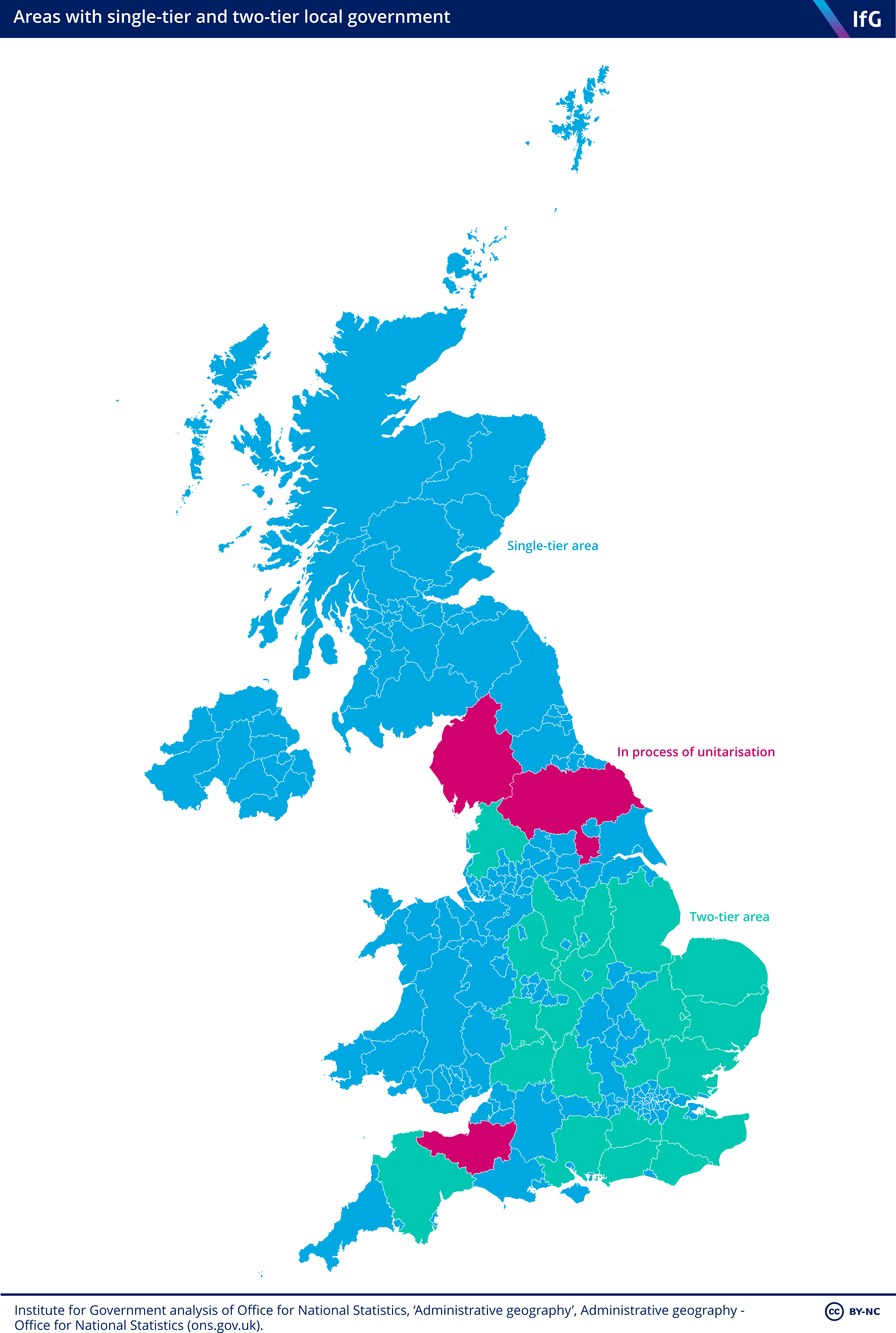Local government unitarisation
Unitarisation is a type of local government reorganisation that replaces county and district councils in ‘two-tier’ areas with a single tier.

What is local government unitarisation?
Unitarisation is a type of local government reorganisation that replaces county and district councils in ‘two-tier’ areas with a single tier of ‘unitary’ authorities.
In two-tier areas, local government functions are shared between an upper-tier county council and a number of constituent lower-tier district councils, which are located within the administrative boundaries of the county council. For instance, the county area of Derbyshire is governed by Derbyshire County Council and eight district councils: Bolsover, Chesterfield, North East Derbyshire, Amber Valley, Derbyshire Dales, Erewash, High Peak, and South Derbyshire.
County councils are responsible for functions such as transport, social care and education. District councils are responsible for matters including housing, planning and waste collection. Unitary authorities are responsible for all these functions within their area.
Unitarisation does not affect parish councils and town councils, the lowest tier of government in England. Parish and town councils are found in some, but not all, unitary and district council areas.
How much of the UK has been unitarised?
The three devolved nations all have forms of unitary local government across their entire territories. The parliament of Northern Ireland created a single-tier pattern of local government in 1972. The UK government implemented unitarisation for Scotland and Wales in 1996.
In England, there are 128 unitary local authorities, covering 59% of the population. These consist of:
- The City of London and the Isles of Scilly, which have unique governance structures and have always been single-tier authorities
- 32 London boroughs, established in 1986 following the abolition of the Greater London Council
- 36 metropolitan districts, established in 1986 following the abolition of metropolitan county councils in Greater Manchester, Merseyside, South Yorkshire, West Yorkshire, West Midlands and Tyne and Wear
- 58 other unitary authorities, established through three distinct waves of local government reform spanning 1995–98, 2007–09, and 2019–present.
The most recent county areas to undergo unitarisation are Northamptonshire, in 2021, and Buckinghamshire in 2020. Buckinghamshire was reorganised into a single unitary authority, while Northamptonshire was split into two unitary authorities: West Northamptonshire and North Northamptonshire.
There are currently 24 county councils in England, sub-divided into 181 district councils.
Following a consultation in 2020–21, in July 2021 the government approved proposals to create two unitary councils in the area covered by Cumbria County Council, and single unitary councils in North Yorkshire and Somerset respectively. The unitary councils will take on the full range of local authority responsibilities on 1 April 2023. 10 Local government update, 21 July 2021, https://questions-statements.parliament.uk/written-statements/detail/2021-07-21/hcws234 Elections for councillors to the four new unitary authorities took place on 5 May 2022.

What is the legal process for unitarisation?
Under the Local Government and Public Involvement in Health Act 2007, the secretary of state can invite a principal authority in a two-tier area (either a county council or a district council) to submit a proposal to form a single tier of local government. This could involve the reorganisation of a county council, a district council or a group of district councils into one or more unitary authorities.
Before implementing a proposal, the secretary of state must consult with every local authority affected by the proposal (except for the authority that made it), and any other person they consider appropriate. The secretary of state can refer a proposal to the Local Government Commission for England (LGCE), but is not required to do so. The LGCE is an independent body which is accountable to parliament through the Speaker’s Committee on the Electoral Commission. The secretary of state can choose to implement the proposal (with or without modifications), implement alternative proposals made by the LGCE, or take no action.
If the secretary of state decides to make an order for local government restructuring, it must be approved by a vote by both houses of parliament to take effect.
Do local authorities have to give consent to unitarisation?
Not necessarily, although the application-based approach to unitarisation and restructuring set out in the 2007 Act means that the process tends to be initiated at a local level, by one or more councils submitting a proposal to the secretary of state. From November 2007 until January 2008, the secretary of state had the power to direct local authorities to submit a proposal for unitarisation when they believed it was in “the interests of effective and convenient local government.” The secretary of state no longer holds this power.
The 2007 Act does not require all relevant local authorities to give consent to a process of restructuring. Several local authorities have held referendums on unitarisation proposals in the past. However, they are not required to do so and the result is not binding on the local authority or the UK government.
What arguments are made in favour of unitarisation?
Supporters of unitarisation argue that local government reorganisation can bring cost savings as merging the two tiers of government creates economies of scale.
It has also been argued that unitary local government can provide public services more effectively than in two-tier areas, where delivery of public services depends on co-ordination between the county and district councils. The simpler structure may also enhance accountability by making it easier for residents to understand who is responsible for public services.
In April 2020, Luke Hall, then minister of state for regional growth and local government, said that: “the government recognises that unitary councils can facilitate more integrated decision-making, better service delivery, greater local accountability and empowered local communities.” 14 Written questions and answers - Written questions, answers and statements - UK Parliament
What arguments are made against unitarisation?
Unitarisation creates larger units of local administration, which are more remote from local communities and may therefore make local government less responsive to local concerns on issues such as planning. Large county areas, such as Surrey and Kent, which have populations of over 1m people, would likely have to be split into several unitary authorities. Unitarisation would therefore involve the abolition of traditional counties, with which many voters identify.
Local government reform can also be costly and disruptive in the short term, even if over the longer term it carries the potential for cost savings.
There does not appear to be strong public support for unitarisation. When local referendums on unitarisation plans have been held, residents have tended to vote in favour of the status quo and against the abolition of lower-tier authorities.
What is the government’s current approach to unitarisation?
In a ministerial statement in October 2020 Robert Jenrick, then communities minister, stated that the government would not impose top-down restructuring of local government but would “continue to follow a locally led approach for unitarisation where councils can develop proposals which have strong local support.” 15 Local government update, 12 October 2020, https://questions-statements.parliament.uk/written-statements/detail/2020-10-12/hcws502 In July 2021, Jenrick further stated that local government reorganisation would not be a prerequisite for proposals for devolution deals to give more powers to county areas. 16 Rt Hon Robert Jenrick MP, Letter to Local Authority Leaders and Chief Executives and Mayors, 15 July 2021, www.emcouncils.gov.uk/write/150721_SoS_MHCLG_letter_-_County_Deals.pdf
- Topic
- Devolution
- Keywords
- Local government Local elections
- Publisher
- Institute for Government